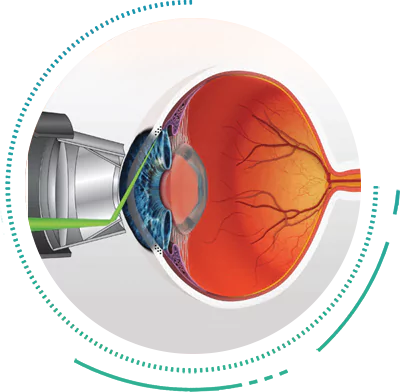Neighborhood Glaucoma Service Near Me: Early Discovery and Treatment Alternatives
Neighborhood Glaucoma Service Near Me: Early Discovery and Treatment Alternatives
Blog Article
Recognizing the Different Vision Adjustment Procedures Available for Clearer View
In the world of vision modification procedures, a plethora of choices exist to resolve refractive errors and give people with more clear sight. From the commonly identified LASIK surgical procedure to much less intrusive procedures like PRK and implantable lenses, the area of ophthalmology uses an array of methods customized to fit various needs and preferences. Each treatment comes with its own collection of factors to consider, benefits, and possible threats. Understanding the nuances of these vision improvement techniques is critical for making educated choices about one's visual health and wellness. Allow's check out the complexities of these procedures and clarified the course to attaining improved vision quality.
LASIK Surgical Treatment
LASIK surgical treatment is a typical refractive treatment utilized to deal with vision issues such as astigmatism, nearsightedness, and farsightedness. This surgical technique, which stands for Laser-Assisted in Situ Keratomileusis, aims to improve the cornea to improve exactly how light is concentrated on the retina, ultimately enhancing vision clarity.
One of the primary advantages of LASIK surgery is the fast enhancement in vision experienced by individuals. In general, LASIK surgical procedure is a prominent selection for people looking for a long-lasting service for their vision issues.
PRK Treatment
While also an usual refractive treatment, the PRK (Photorefractive Keratectomy) technique differs from LASIK surgery in its technique to remedying vision troubles. In PRK, rather than producing a flap on the cornea, the external layer of the cornea, called the epithelium, is entirely eliminated. This permits the laser to improve the cornea to remedy refractive mistakes such as nearsightedness, astigmatism, and farsightedness directly externally.

Regardless of the longer healing time, PRK can yield excellent lead to vision improvement, making it an important choice for those that might not appropriate prospects for LASIK surgical procedure.
Implantable Lenses
Unlike PRK where the cornea is improved straight, implantable lenses use an additional approach for dealing with vision by putting artificial lenses inside the eye. This treatment is particularly beneficial for people with high degrees of astigmatism, farsightedness, or nearsightedness that may not be appropriate prospects for laser surgeries like LASIK or PRK.
Implantable lenses, likewise referred to as phakic intraocular lenses, work by supplementing the eye's all-natural lens with a synthetic one. refractive surgeries in al. These lenses can be placed before the natural lens (anterior chamber) or behind the iris and in front of the natural lens (posterior chamber) By changing the power and positioning of these lenses, eye doctors can efficiently correct refractive mistakes and enhance aesthetic skill
One benefit of implantable lenses is that they are exchangeable and detachable, giving flexibility for future changes. Nonetheless, as with any type of operation, there are threats involved, such as infection or cataract formation. Patients taking into consideration implantable lenses need to seek advice from an eye treatment professional to Get More Information determine the most ideal choice based upon their specific requirements and eye health and wellness.
Corneal Rings
Corneal rings, likewise called intracorneal ring segments, are tiny, clear tools placed into the cornea to remedy vision distortions such as keratoconus. Keratoconus is a problem where the cornea thins and protrudes outward, causing vision to end up being altered. The insertion of corneal rings aids to flatten the cornea, enhancing visual acuity and lowering the irregular astigmatism brought on by keratoconus.
The procedure for placing corneal rings is minimally intrusive and relatively fast, typically carried out as an outpatient procedure. During the surgical treatment, the ophthalmologist makes a tiny cut in the cornea and inserts the rings at a specific deepness. Once in area, the rings aid to improve the cornea, giving a smoother surface area for light to enter the eye, which can cause more clear vision.
Corneal rings are considered a reversible procedure, as they can be removed or replaced if needed. refractive surgeries in al. While they may not entirely get rid of the requirement for glasses or call lenses, corneal rings can significantly enhance vision high quality and overall aesthetic comfort for people with keratoconus or other corneal abnormalities
Refractive Lens Exchange
Adhering to the adjustment of corneal abnormalities with treatments like corneal rings, another vision adjustment technique that can resolve refractive mistakes is Refractive Lens Exchange (RLE) RLE is a procedure that entails replacing the eye's all-natural lens with a man-made intraocular lens (IOL) to deal with refractive mistakes such as farsightedness, nearsightedness, and presbyopia. This procedure is especially valuable for individuals who may not be ideal prospects for procedures like Learn More Here LASIK or PRK due to elements such as thin corneas or high refractive errors.

Final Thought
In final thought, there are numerous vision correction treatments offered to aid people accomplish more clear view. LASIK surgery, PRK treatment, implantable lenses, corneal rings, and refractive lens exchange are all choices that can resolve various vision problems.
In the realm of vision modification treatments, a wide range of choices exist to deal with refractive errors and offer people with clearer sight.LASIK surgery is a common refractive treatment made use of to deal with vision issues such as nearsightedness, astigmatism, and farsightedness.While also an usual refractive procedure, the he said PRK (Photorefractive Keratectomy) technique differs from LASIK surgical procedure in its method to remedying vision problems.Following the improvement of corneal abnormalities with procedures like corneal rings, another vision improvement method that can resolve refractive errors is Refractive Lens Exchange (RLE) LASIK surgical procedure, PRK treatment, implantable lenses, corneal rings, and refractive lens exchange are all alternatives that can resolve various vision problems.
Report this page